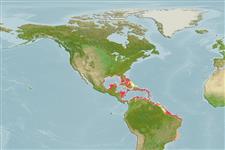>
Eupercaria/misc (Various families in series Eupercaria) >
Haemulidae (Grunts) > Haemulinae
Etymology: Anisotremus: Greek, anisos = unequal + Greek, trema, -atos = hole (Ref. 45335).
More on author: Linnaeus.
Environment: milieu / climate zone / depth range / distribution range
Ecologia
marinhas associadas(os) a recifes; intervalo de profundidade 2 - 70 m (Ref. 9710). Subtropical; 32°N - 33°S, 98°W - 34°W
Western Atlantic: Bermuda (introduced) and Florida, USA to Brazil, including the Gulf of Mexico and the Caribbean Sea (Ref. 9626).
Tamanho / Peso / Idade
Maturity: Lm ? range ? - ? cm
Max length : 40.6 cm TL macho/indeterminado; (Ref. 40637); common length : 25.0 cm TL macho/indeterminado; (Ref. 3798); peso máx. publicado: 930.00 g (Ref. 40637)
Espinhos dorsais (total) : 12; Raios dorsais (total) : 16 - 18; Espinhos anais: 3; Raios anais : 9. Body striped yellow and silvery blue; fins yellow, 2 black bars: one from nape through eye to mouth, another from origin of dorsal fin to base of pectoral fin. Only grunt fish in the Caribbean with two vertical black bars and yellow stripes. (Ref. 26938).
Maximum depth from Ref. 126840. Inhabits reefs and rocky bottoms. Feeds at night on mollusks, echinoderms, annelids, and crustaceans (Ref. 3798). Young pick parasites from the bodies of larger fishes (Ref. 5521). Young are popular aquarium fish (Ref. 7251). Marketed fresh (Ref. 3798). Has been reared in captivity (Ref. 35420).
Ciclo de vida ou comportamento de acasalamento
Maturidade | Reprodução | Desova | Ovos | Fecundidade | Larvas
Distinct pairing during breeding (Ref. 205).
Robins, C.R. and G.C. Ray, 1986. A field guide to Atlantic coast fishes of North America. Houghton Mifflin Company, Boston, U.S.A. 354 p. (Ref. 7251)
Status na Lista Vermelha da UICN (Ref. 130435: Version 2024-2)
Ameaça para os humanos
Reports of ciguatera poisoning (Ref. 30303)
Uso pelos humanos
Pescarias: pouco comercial; peixe esportivo: sim; Aquário: Aquários públicos
Ferramentas
Relatórios especiais
Baixar XML
Fontes da internet
Estimates based on models
Preferred temperature (Ref.
123201): 24.9 - 28.2, mean 27.4 °C (based on 791 cells).
Índice de diversidade filogenética (Ref.
82804): PD
50 = 0.5039 [Uniqueness, from 0.5 = low to 2.0 = high].
Bayesian length-weight: a=0.01514 (0.00889 - 0.02578), b=3.05 (2.90 - 3.20), in cm total length, based on LWR estimates for this species & (Sub)family-body (Ref.
93245).
Nível Trófico (Ref.
69278): 3.6 ±0.5 se; based on diet studies.
Resiliência (Ref.
120179): médio(a), tempo mínimo de duplicação da população 1,4 - 4,4 anos (Preliminary K or Fecundity.).
Fishing Vulnerability (Ref.
59153): Low to moderate vulnerability (31 of 100).
Nutrients (Ref.
124155): Calcium = 22.6 [10.1, 62.8] mg/100g; Iron = 0.538 [0.258, 1.056] mg/100g; Protein = 19.6 [17.7, 21.7] %; Omega3 = 0.144 [0.066, 0.285] g/100g; Selenium = 13.1 [5.8, 27.3] μg/100g; VitaminA = 35.1 [9.5, 131.4] μg/100g; Zinc = 0.673 [0.404, 1.106] mg/100g (wet weight);
